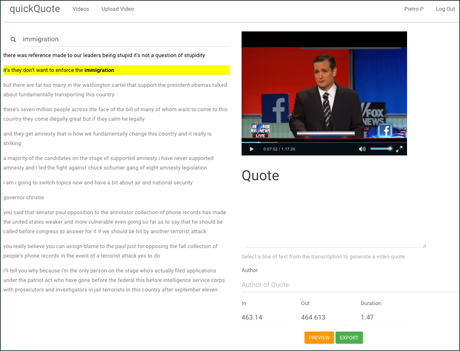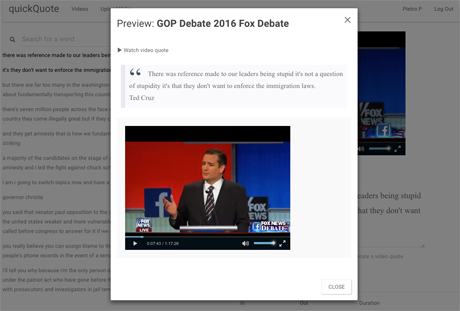
Quotes are often the most interesting part of a story. They can help the audience relate or identify more with the topic and strengthen the reporting, but quoting a source in text often doesn't do justice to the impact their words could have in audio or video form.
This is why The Times is testing quickQuote, a tool that uses videos and automatic transcription to make quotes easier to find and use in articles.
"The initial problem was finding a way to make it easier and more interesting to work with video in the newsroom," said Pietro Passarelli, former newsroom developer intern at The Times, who developed quickQuote.
Earlier this year, The Times also experimented with audio quotes, using the format in its multimedia coverage of the 7/7 bombings anniversary.
It allowed the user to link an audio file to its corresponding text quote, but cutting the audio and finding the quote beforehand had to be manually done by the user, which "in a 20 minute video with no transcription took an enormous amount of time".
QuickQuote, which was open-sourced last week, requires users to upload their video footage and then provides an automated transcription using natural language processing.
After the transcription is generated, the user can click anywhere in the text to see and hear the corresponding video and audio, highlighting their desired quote with their mouse.

Screenshot from quickQuote.
After choosing the quote, the journalist can add the speaker's name, occupation or any other relevant information before previewing and ultimately exporting it as a video.
Passarelli explained the exporting process is similar to when people tweet certain quotes from Medium articles, where the platform automatically creates a Twitter card with the quote selected by the user, the article's author and a link to the post.
At The Times, quickQuote has been integrated with the newsroom CMS to make it easier and quicker for journalists to use, but for anyone else the tool generates an embed code.
QuickQuote does not have any restrictions in terms of video size or duration. However, it uses a program called Spoken Data to complete the automatic speech-to-text transcription which only gives users 15 minutes of transcription for free before they have to pay.
This imposes a limitation on the length of time reporters can use quickQuote for free, although alternative transcription software is available and can be linked to the tool.

Screenshot from quickQuote.
The Times tested quickQuote behind-the-scenes with a case study on Donald Trump's best quotes – it can be used either with text or video as a starting point.
"You might already know which the best quotes are because you review what has already been published and think 'this quote is good', but finding the actual video for it can take time," Passarelli told Journalism.co.uk, explaining how the tool can used to quickly find a certain segment in a longer video.
"Or it may be a different scenario in which you have an interview or debate that you haven't watched yet and with quickQuote, you can watch it with the text next to it and select the quotes that you want as you go along."
And because the video quotes are trimmed, journalists don't have to worry about uploading an hour worth of video just to showcase a powerful quote.
This can help save time and bandwidth, and means anyone can add a video component to their story without having to rely on a multimedia team to edit the footage first.
QuickQuote has only been tested on political speeches or debates so far, but Passarelli thinks it could be useful in other situations, as "seeing and hearing someone say something can change the meaning of what they're saying and give you a better feel of the person".
He would like to expand the tool in the future to support external video URLs from YouTube and other platforms, as well as develop a feature that would automatically cut and export the video to Twitter through the platform's API.
Update: This piece has been edited to clarify The Times has not developed a tool for audio quotes, but has experimented with the format.
Free daily newsletter
If you like our news and feature articles, you can sign up to receive our free daily (Mon-Fri) email newsletter (mobile friendly).
Related articles
- Newsrewired special: How The Times is running towards a digital-first future
- Subscription retention strategies: pain points and remedies
- How should the media cover COP26 and climate change long-term?
- Ben Spencer, science editor, The Sunday Times, on the future of climate journalism
- Coronavirus, statistical chaos and the news, one year on









